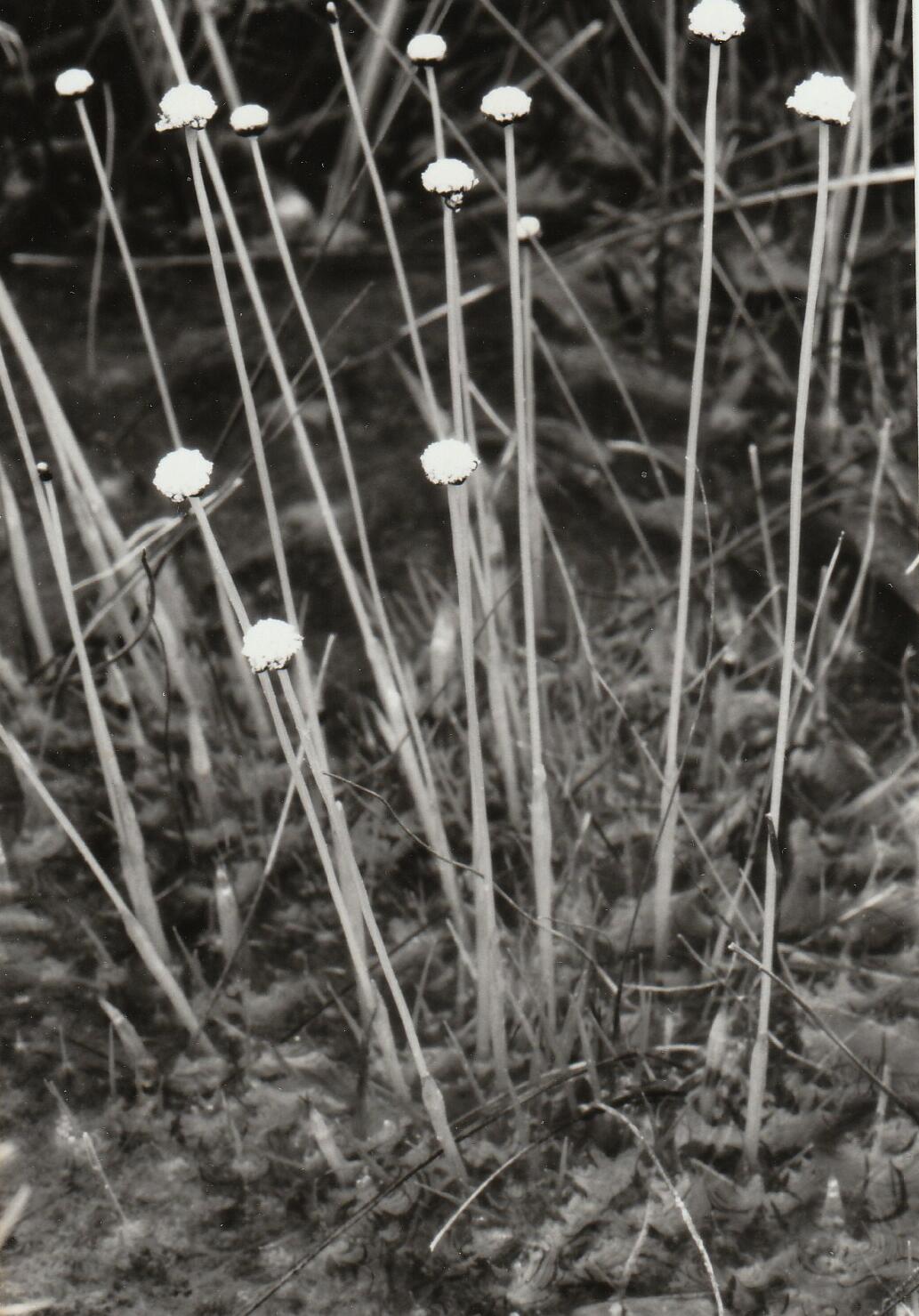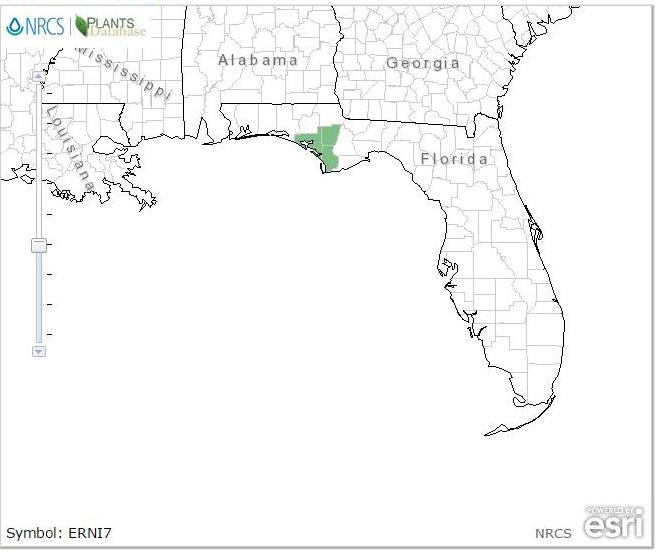Eriocaulon nigrobracteatum
| Eriocaulon nigrobracteatum | |
|---|---|

| |
| Eriocaulon nigrobracteatum, photo in natural habitat by John Palis | |
| Scientific classification | |
| Kingdom: | Plantae |
| Division: | Magnoliophyta - Flowering plants |
| Class: | Liliopsida - Monocotyledons |
| Order: | Eriocaulales |
| Family: | Eriocaulaceae |
| Genus: | Eriocaulon |
| Species: | E. nigrobracteatum |
| Binomial name | |
| Eriocaulon nigrobracteatum E. L. Bridges & Orzell | |

| |
| Natural range of Eriocaulon nigrobracteatum from USDA NRCS Plants Database. | |
Common name: Blackbract pipewort
Contents
Taxonomic notes
Synonyms: none.[1]
Varieties: none.[1]
Description
Perennial, forming large dense clumps by basal offshoots. Leaves in a basal rosette, whitish below, dark green above, linear-attenuate, 0.5-1.5(-4.0) cm long, 0.3-1.0 mm wide, irregularly and incompletely septate, tapering evenly from a pale, aerenchymatous base. Sheath of scape much longer than the leaves, 1.5-2.0(-4.9) cm long, the orifice loose, oblique, hyaline, bifid. Mature scape delicately filiform, light green, 5-15(-19) cm long, 0.2-0.3 mm broad, strongly twisted, mostly 4 ridged. Mature heads hemispherical, sometimes globose when pressed, 3.0-4.0(-5.0) mm broad, dark gray to black below due to the exposed involucral bracts, white above due to the densely white-hairy tips of the perianth parts and bractlets. Surface of the receptacle smooth. Outer involucral bracts broadly ovate to orbicular, 1.0-1.3 mm long, 0.9-1.2 mm wide, smooth, dark gray to black, the tips rounded, entire. Receptacular bractlets about 1.0 mm long, broadly ovate, uniformly dark gray or slightly lighter yellowish or whitish at base, the apex densely white clavate hairy on the back and margin. Male flower: sepals gray- translucent, oblong, ca. 1.2 mm long, concave-curvate, obscurely keeled, the apex rounded, the outer apex and upper margin densely white clavate hairy. Petals subequad, pale, largely found in a narrowly cylindrical structure about 1.1 mm long, acute, the inner surface around the glands and the margins of the petal lobes with white clavate hairs. Anthers black, broadly ellipsoid, ca. 0.2 mm long, very slightly exserted or not exerted from the head on short white filaments. Female flower: sepals oblong, slightly curvate-keeled, ca. 1.0 mm long, gray- translucent, white clavate on the back and upper margin. Petals oblong, ca. 1.0 mm long, obtuse, the upper inner surfaces and upper margins white clavate hairy, the inner surface also densely hairy with long, clear, multiceUiilar trichomes, capsule light brown, bicarpeUate, 0.6-0.7 mm wide, ca. 0.3 mm high, seeds orbicular, ca. 0.3 mm long, very obscurely reticulate. Edwin L. Bridges
Additonal description information of Eriocaulon nigrobracteatum is provided in The Flora of North America.
Distribution
Eriocaulon nigrobracteatum is a narrow endemic which at the time of its description as a new species in 1993 was known from eleven sites in eastern Bay (6), and adjacent western Calhoun (2) and northwestern Gulf (3) counties, an area encompassing approximately 689 km^ (265 sq mi) in the east-central Florida panhandle. The currently known sites are within an area bounded on the east by the lower Chipola River and lower Apalachicola River valleys, extending westward to Bear Creek and its tributaries which discharge to Econfina Creek in north-central Bay County. All eleven sites are within the Gulf Coastal Lowlands physiographic region (see Brooks 1981; Puri & Vernon 1964), with seven occurring along major south flowing drainages and their tributaries (Sandy and Wetappo Creeks). Four sites occur on the southern portion of the Fountain Slope, the northernmost extension of the Gulf Coastal Lowlands. Edwin L. Bridges
Ecology
Habitat
Nearly all of the sites for Eriocaulon nigrobracteatum occur in mires on deep unstable sapric mucks of lower slope seepage fed herbaceous communities, which are referred to by its authors as poor fens. Poor fens are oligotrophic to weakly minerotrophic, weakly ionic, somewhat acidic, nutrient deficient, mires which are poor in species of Sphagnum. Poor fens of the Florida panhandle are known to the authors to occur along the middle and upper reaches of small stream valleys and their tributaries in the eastern part of the St. Andrews Bay drainage, within the western portion of the Apalachicola Embayment. The surface soil of most of the poor fens is a black decomposed muck (pH 5.4-5.6), sometimes mixed with coarse sand. The depth of the muck layer varies from 30 cm (12 in) to at least 2.2 m (7 ft) and is autochthonous, having originated with the growth of the sedges, with little wood or Sphagnum moss present in the muck. One site on Wetappo Creek was underlciin by a gray sandy clay layer at a depth of 30 to 45 cm. All other sites were underlain by coarse sand below the muck. The muck substrate is very fluid and contains large, water filled, vacuous channels, making determination of stratification extremely difficult. Soil surveys of these counties have not been conducted in sufficient detail to distinguish a specific poor fen soil type. The soils of these sites would probably be classified in the existing surveys as Rutlege (Typic Humaquepts), Pamlico (Terric Medisaprists), or Dorovan (Typic Medisaprists), with increasing depth of the organic surface. The Wetappo Creek site with the clay substratum would probably be classified as a Pantego (Umbric Paleaquuits), Rains (Typic Psileaquults), or Pelham (Arenic Paleaquults) soil. Edwin L. Bridges
Associated species include Sarracenia, Drosera, Utricularia, and Juncus. [2]
Phenology
Flowering in March and April, with mature seeds in April and May; scapes and inflorescences scarcely or not at all visible in other seasons. Edwin L. Bridges
Conservation, cultivation, and restoration
Cultural use
Photo Gallery
References and notes
- ↑ 1.0 1.1 Weakley, A.S. 2015. Flora of the southern and mid-atlantic states. Working Draft of 21 May 2015. University of North Carolina at Chapel Hill, Chapel Hill, North Carolina.
- ↑ Florida State University Robert K. Godfrey Herbarium database. URL: http://herbarium.bio.fsu.edu. Last accessed: October 2015. Collectors: Loran C. Anderson, Bill Boothe, Edwin L. Bridges, V. Craig, R. Hilsenbeck, Ann Johnson, Jennifer Johnstone, Patricia Kelly, Lisa Keppner, T. MacClendon, K. MacClendon, Steve L. Orzell. States and Counties: Florida: Bay, Calhoun. Compiled by Tall Timbers Research Station and Land Conservancy.